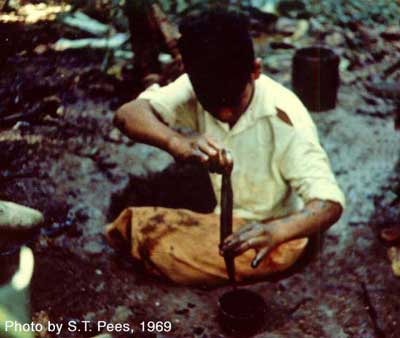 |
||||||
Seeps
At some localities oil migrated to the surface and was seen as seeps on land and in the creeks. The oil was dipped from some of these seeps, even those in Oil Creek where baffles were used to form eddies from which the floating oil could be gathered. These activities were undertaken by the earliest settlers and itinerants in the oil belt. Obtaining seep oil became more permanent at the better sites such as the seep in Oil Creek on the Hamilton McClintock parcel from which as much as 1250 gallons of oil could be trapped and kegged during the seasons when the creek was free of ice and not in flood.
Water was almost a requirement for a good working seep because it facilitated the gathering process by allowing the floating oil to be skimmed off. It is possible that the pioneer oil gatherers of the 19th century dug shallowly into the ground of the surface seeps so that a puddle of water could collect during rains and thus let the oil seek its place by rising to the top. Mention is made by John Reynolds (1938) of an early gatherer who shoveled oily gravel from a bank seep into a canoe and then poured in water so that he could skim off the oil which otherwise couldn't be effectively separated from the gravelly muck. The physics of this principle (oil floating on water) has been used in the production of oil and associated brine throughout the entire span of the oil industry.
Of the various historic oil seeps in northwest Pennsylvania which the author has found mention of in the literature and which visits were made to, no trace of oil remains visible to the eye. An occasional bursting rainbow in Oil Creek may be a drop escaping from an old well or a buried pipe. One would like to think more, but it is not likely that an ancient seep would revitalize significantly and sustain itself in this old pressure-depleted and abandoned oilfield. Still, it is a loss not to be able to see the seeps as they were when they beckoned our oil pioneers.
 |
Rare, local, itinerant oil sheen on Oil Creek. |
The baffles mentioned previously on the H. McClintock parcel were partly a string of boulders placed in an arc so as to delay the current. Oil Creek is shallow and usually clear, the stony bottom being easily seen. At low water it is a series of gravel bars and can be waded everywhere. Large rocks stud its surface here and there. One ponders which of the many boulders in the creek in the vicinity of Hamilton McClintock's parcel may have served in the simple, rude barricades put up in his early oil gathering process in the creek waters. It was a historic enterprise.
Gathered oil sold in the 1790's for $4.00 to $5.00 per gallon (and more) delivered by foot, horseback, or raft to Pittsburgh. This would amount to over $200 per 42 gallon barrel (the modem barrel). By 1807 the price was $1.00 to $2.00 per gallon ($84.00 per barrel) (Giddens, 1938). Hamilton McClintock probably sold his oil in the latter range.
The use of wool blankets to catch floating seep oil was said to be common in the first half of the 1800's. After a blanket was laden with oil, the oil seeker would simply wring it out over a container. Hamilton McClintock used blankets to sop up the oil at his working seep.
It should be remembered that wool blankets were brought to North America by Europeans. The Native Americans had none before this.
In 1792 Tobias Hirte (Titusville Herald, 1971), a trader between Philadelphia and the frontier, wrote of seeing Indians use feathers which they would dip into a seep to bring up oil. The oil clung to the feather. This is not unlikely. In 1969 the author was studying the geology of Tonga, an island in the South Pacific. The presence of oil on water was noted in a freshly dug pit. A boy, hired to obtain a sample, used a piece of a palm frond to collect the oil. It clung to the frond. He let the oil drip off the frond into a container, but the process was a slow one. It took him nearly a day to obtain half a quart (Pees, 1983).
 |
A young fellow on Tonga, an island in the South Pacific, gathered oil from a pit by using a palm frond, This photo shows him in the pit wiping the oil off the frond with his fingers. It is being caught in a tuna can. He later partly filled a bottle for the author. Photo 1969 by S.T. Pees. |
![]()
| © 2004, Samuel T. Pees all rights reserved |
|